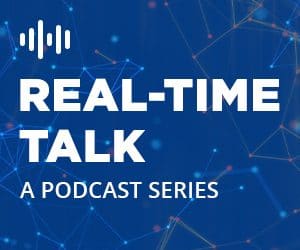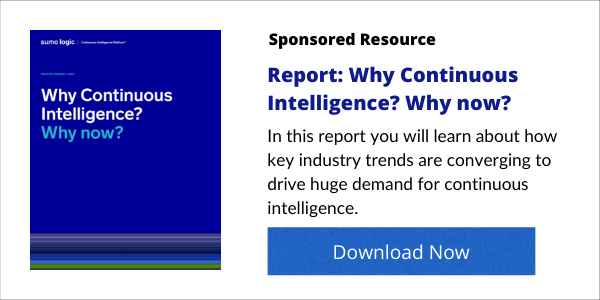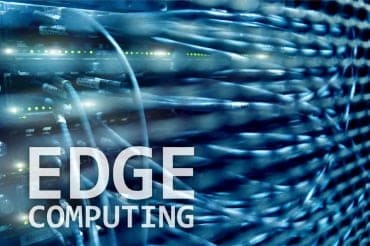
RTInsights editor Joe McKendrick and Sumo Logic CTO and Co-Founder Christian Beedgen offer advice for developing a continuous intelligence strategy to support digital transformation efforts.
In this RTInsights Real-Time Talk podcast, Joe McKendrick, Industry Insights Editor at RTInsights, and Christian Beedgen, CTO and Co-Founder at Sumo Logic, discuss how digital transformation is changing the way IT delivers services and capabilities to organizations, what is needed to assure the success of a digital transformation effort, and the role of continuous intelligence in helping to achieve the goals of digital transformation.
About the Continuous Intelligence Insights Center:
From real-time fraud prevention to enhanced customer experience to dynamic energy load balancing, businesses of all types and sizes are realizing the benefits of Continuous Intelligence, helping them make decisions in real-time while events are happening.
Where do you begin? What are the key requirements? RTInsights’ Continuous Intelligence Insights center, sponsored by Sumo Logic, brings together the latest insights and advice on continuous intelligence to answer these questions and more.
See Also: Continuous Intelligence Insights
Read the podcast transcript:
McKendrick: Welcome everyone to our podcast series on continuous intelligence. This is Joe McKendrick, industry analyst with RTInsights, and we’re very pleased to have you with us today Christian Beedgen, chief technology officer and founder of Sumo Logic. He founded Sumo Logic back in April 2010, is that right, Christian?
Beedgen: Yes, that’s right. Twelve seasons.
McKendrick: Wow. Twelve years now. And Sumo Logic, from what I understand, you handle close to 900 petabytes of data per day on your platform, and you also manage about 19 billion events per second, is that right? Sounds like you’re a very busy company there.
Beedgen: Yes, we’re very busy. Thanks for having me. And yes, we’re in our 12th season. I haven’t looked at it like that, but this is about the time when the script starts to introduce alternative realities. But yes, we’re going strong. We got together to start this company back in 2010 to take, essentially, what at the time you mostly called log management, into the SaaS world, solving analytics and monitoring problems for operations and security. And I think one of the big things that we brought to the table was the insight back then that this type of tool, which was previously already being established, as SiEM and Splunk, for example, was also sort of our background.
It was very useful to have a way to deal with sort of non-traditional data and drive analytics. It was all delivered as enterprise software. I think now, 12 years later, I think that’s not new news anymore, right? That’s not very efficient, but I think we were very early there in our space to propose to make this into a SaaS and build it on top of cloud services. Boy, the world has certainly validated that hypothesis in terms of our way, and it has happened much faster than we could have even imagined. And so here we are public company now. And yes, what we do is, it’s all about data, it’s all about basically event type data. Data that is mostly coming out of IT infrastructures. It’s the logs, metrics, and various forms of telemetry. We can drive use cases to keep your unit systems and maps secure and reliable.
And then there is an emerging, sort of emerging kind of case there as well, where all users are using us for more sort of business analytics type use cases, driving from mostly, in many cases, the logs that the applications generate. You have a lot of transactional data and a lot of data about how our users interact with their systems, and that is obviously business relevant. And then we can do those charts that have the dollars on the Y axis, right? And then we have business analytics. So, it’s quite interesting. And yes, it’s a cloud service. All the data comes to us, and we process it on behalf of our customers and make it available for analysis. And the volumes are staggering. Yes, they’re definitely staggering. I’m very, very happy and proud of the team that built a system that can scale to that level. We like to say it is planetary scale.
McKendrick: What a great, fascinating story. And just hearing about your experience from the startup stage now to a public company, a fantastic success story in this digital economy. And as I’m sure you’ve seen among your customer base that everybody wants to become a software company. Especially over the past two years, everybody wants to be digital, and everybody wants to be a software company. We had a huge rush to digital since the pandemic started in 2020, about two years ago now. How do you see digital transformation changing the way IT delivers services and capabilities? There’s a lot of pressure now on IT to really make this happen. We want to be a software company, but we have to rely on our IT department to make this so, correct?
Beedgen: Yes. The way that we look, I mean, I think this is kind of almost sort of, they’re saying digital transformation is kind of the driving force for businesses in the 21st century. And because simply competition is a reality, people have found that delivering products in a digital way makes them more competitive., And whether you like it or not, if you don’t like it, your competitors outdo you, and so there’s just more efficiency in terms of getting to customers and in terms of transacting and ultimately, making money, which is the goal of every business, right?
And so, therefore, whether you are a Silicon Valley business, or you’re born and raised in the cloud along Highway 101, that’s one thing, but I think the real wave here is coming from all sorts of traditional businesses that are now faced with trying to figure out how to transform, hence, digital transformation. And so now the question then becomes, how do you execute on that? And that is definitely a non-trivial challenge. One way to summarize it is that there are two main challenges. One is technology, and technology that’s changing. And the other one is culture, and culture that’s changing.
Related: Digital Transformation Requires Continuous Intelligence
On the technology side, the way that I look at it is that traditional IT has a mindset of owning physical things. You have these deep emotional relationships to the hardware, and for a good reason, because hardware’s cool, right? We’re all nerds here. But you have some notion of geographic locations, you have physical access, and then on the security side, that extends on this idea that if you guard the perimeter around the physical location of your hardware and infrastructure, that helps with the major thing of how you secure access to it.
But the reality is that in the last, I would say, 10 to 15 years, this has radically changed. There’s just no physical location anymore. I mean, maybe Virginia because you happen to know that the classic AWS availability for that particular region is in Virginia, at least so that they said, who knows where they are these days? Being aware where there is a cable that has internet on it coming out of the ground, there probably is AWS, right? But in any case, it’s becoming all completely virtual, and it’s becoming all driven to APIs and automation. That is something that traditional IT continues to have to transform to understand.
An additional thing about technology that I feel is coming through is that not only is infrastructure changing, but the way that the applications are built to conduct the digital business right on top of it has also been changing. This is the part where AWS or the other hyperscalers do not just provide your infrastructure. You use that infrastructure to build, not to deploy, an MS access database. But you have these large distributed applications running on top of it that are supposed to be reliable, very secure, and that are supposed to run 24/7.
And on top of this new type of infrastructure, you now have new deployment, abstractions, and Kubernetes. They are used to build and efficiently deploy these large, distributed applications. And all of this enables you to build fantastic, fantastic things with increasingly fewer people. But the complexity and the depth of understanding that those people need to have is just staggering. And that creates all sorts of challenges for traditional IT. And so, digital transformation is also, I feel, like IT transformation.
Watch Video Now: Digital Complexity and How to Address ItMcKendrick: What I hear you saying, of course, is we may have all these wonderful cloud resources, AWS, you mentioned there’s Microsoft Azure, but it doesn’t mean IT teams are going to go away. It means their responsibilities are still there. You’re not turning over responsibility for overseeing your IT infrastructure to the cloud. You still have that IT infrastructure existing somewhere that you need to oversee and monitor. Is that right?
Beedgen: Absolutely. It’s not that AWS builds and runs the application for you, right? They just provide the giant shoulders to stand on just like VMware had done before. It’s just the layer of obstruction, and the amount of visualization is sort of rising.
I do think that the roles in IT are transforming, and I think they are transforming more towards the direction of folks ultimately becoming developers or programmers in the wider sense. And by that, I don’t mean super high-end digital, a Stanford Ph.D. in distributed systems. But a lot of people are programmers whether they work as a developer or not. And that’s an incredible power. That’s how we see IT roles developing and transforming into a role that helps build the applications, automate the deployment of the applications, and the operations of the applications.
Related: As the Role of the SRE Evolves, so Too Do Required Skills
At the type of scale and requirements that you have for the applications, you’re not really clicking around an admin interface anymore. The work is basically all API-driven, which means that scripting, programming, understanding, configuration management, and XS codes tooling become important. So, many folks find themselves in essentially developer roles. And many of the more classic developer types that have a CS degree realize how much of an operational mindset they have to adopt. They have to come to something that’s maybe a little bit more native to some of the classic IT folks because now you don’t just build. You also have to run the application.
And then the next step of that is security, where we talk about DevSecOps, Shift Left, and all of those types of things. The way that we look at it is that, ultimately, the thing that drives a successful business, given digital transformation, is the apps that conduct the business. And those apps are built to scale, built internally with help from consulting, and built on top of open source. It’s like a voodoo doll crafted from various bits, and I think that’s actually very cool because it avoids a lot of mono-culture issues that were there before. The end result might not be the most aesthetically pleasing thing, but production systems have never been aesthetically pleasing. But they actually work. That’s a whole different level of abstraction of pleasing.
Download Now: Solving the SOC Bottleneck - Automated Detection and AnalyticsAnd I think that’s the transformation. The way I look at it is that IT security, business analysts, and others all basically become essentially programmers and analysts that flock around those mission-critical applications. And those mission-critical applications, that’s the stuff where revenue gets generated, and that’s where you see the cloud adoption, cloud-native architectures, and all the good and bad that comes with that.
The second thing I was going to talk about has to do with cultural transformation. Many of the things we have been doing quite successfully over maybe the last 20 plus years in software development have shifted. They have transformed from the classic program management office, huge process, and three-year projects. Now instead of this extreme programming, we have agile development, DevOps, and the sort of philosophical underpinnings of having a strategy but not trying to plan execution out for more than whatever horizons that you can see, which is, when it comes to technology, usually a couple of weeks. Basically, you’re trying to do the right thing given what you know. You’re not trying to anticipate too much because predicting the future is very hard.
And I do think that there’s also, when I look at traditional IT, I think this sort of adoption of Azure processes is also still something to consider. The lines of business need to generate revenue and applications built, deployed, and maintained. Those folks are also prone to huge project plans and stuff like that. And it’s just that you need to move quickly because the world changes with your technology, insights, and competition. The incremental approach, the agile approach, I’d say, has, by and large, the current best approach. Yes, you need a strategy. But you must be very flexible in execution. Don’t spend time planning things you can predict; just do fewer meetings, more typing, and stuff like that. So, digital transformation begins for the entire enterprise with technology and culture transformation.
McKendrick: That’s an excellent thought to leave us here within our first podcast of the series, Christian. We see the rise of the developer as an adjunct to the business, as an advisor to the business, and the business side is learning development and becoming citizens developers. It’s all coming together, right?
Related: The Future is Enterprise-Wide Intelligence
Beedgen: Yes. That’s how we see it. And I’m pretty sure that these things never stop. The one thing that we know is that change is the only constant. And whatever is true today is not going to be true tomorrow. So, when we talk again in a year, I’m sure some of these things will change again.
McKendrick: That’s wonderful. Thank you. Thank you very much, Christian. Great talking with you for the session. And folks, tune in for the next session in our series where we’ll talk about ensuring the reliability of these systems, these cloud-based and converged environments that we’re moving into this decade. Thank you very much, Christian.
Beedgen: Thanks for having me.
McKendrick: We’ll talk to you again.







